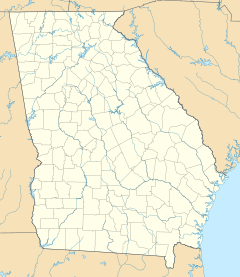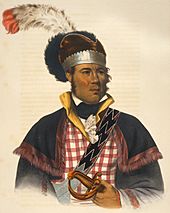Acorn Creek facts for kids
Quick facts for kids Acorn Creek |
|
|---|---|
| County | Carroll County, Georgia |
| Physical characteristics | |
| Main source | 33°30′45″N 84°56′20″W / 33.5126123°N 84.9388292°W |
| River mouth | 33°27′10″N 84°58′25″W / 33.4528915°N 84.9735517°W |
| Basin features | |
| cities | Whitesburg, Georgia Acorn Town (extinct) |
Acorn Creek is a small stream in Carroll County, Georgia. It flows into the Chattahoochee River. The creek is about 666 feet above sea level. It's an important part of the local environment.
What's in a Name?
Acorn Creek got its name from a place called Acorn Town. This was a settlement and plantation of the Creek Indian people. It was located near where the creek flows into the Chattahoochee River.
The original name for this stream in the Muskogee language was Lakcv-hache. The plantation was home to Chief McIntosh, a leader of the Lower Creek people. It was also known as Acorn Bluff or Lochau Talofau.
A Look Back in Time
Today, Acorn Creek is near the McIntosh Reserve. This is a 527-acre outdoor recreation area. The Carroll County Recreation Department runs it. Carroll County bought the land, Lochau Talofau, in 1978. They then created the Reserve. The Reserve includes part of the larger Acorn Bluff plantation from the 1800s.
The Reserve is named after William McIntosh. He was a well-known Creek Indian leader and planter. He had a home and plantation at this site. McIntosh called his plantation Lochau Talofau. This means Acorn Bluff in English. It was about one square mile and included the lower parts of Acorn Creek.
At Acorn Bluff, McIntosh built a simple two-story log house. He used it as his home and as an inn for travelers. A copy of his house was built after the Reserve was bought. Visitors to the park can see it.
McIntosh and the Lower Creek tribes helped the United States government. They fought against the British and their Red Stick Creek allies. This was during the Creek War of 1813-1814. McIntosh showed great bravery in battles like Autossee and Horseshoe Bend. He was promoted to Brigadier-General. He also fought with General Andrew Jackson in the First Seminole War (1816-1819).
McIntosh was a hero to many. However, he angered many of his fellow Creeks in 1825. This happened when he signed the second Treaty of Indian Springs. This treaty sold almost all Creek lands in Georgia and Alabama to the U.S. government. McIntosh was allowed to keep his plantation for signing the treaty.
The Creek National Council did not agree with selling their ancestral lands. They said it was not allowed and was against their laws. The Council had previously thought about punishing McIntosh for another treaty. But the 1825 treaty led to his death. The Council decided that McIntosh and others who signed had committed a serious offense. They ordered their deaths for giving away shared lands. McIntosh died at his home, Acorn Bluff, in 1825.
McIntosh's grave is in the McIntosh Reserve. It is next to his rebuilt home. A Georgia Historical Marker (022-3, from 1984) shows where Brigadier-General McIntosh's home and burial site are.
The Land and Water
Acorn Creek starts just west of Whitesburg, Georgia. It then flows into the Chattahoochee River in Carroll County. The area where Acorn Creek and the Chattahoochee River meet has a total area of 28,284 acres. This area is part of a much larger watershed called the Middle Chattahoochee-Lake Harding watershed.
In Carroll County, near where Acorn Creek joins the Chattahoochee River, you can see signs of the Brevard Fault. A fault is a crack in the Earth's crust. This fault is a geological feature that stretches across several states. From Atlanta to eastern Alabama, including the Acorn Creek area, the rocks of this fault are visible. They are usually less than 600 feet wide but stretch for 80 miles.
The Chattahoochee River, at McIntosh Reserve, becomes shallow. A guide to the area says the "rugged landscape" shows the Brevard Fault zone. This fault line is clear where the river banks have "huge boulders" that rise 80 feet above the water. A few miles downstream from Acorn Creek, the Brevard Fault leaves the Chattahoochee River. It then continues southwest into Alabama.
McIntosh Reserve Park was closed for several months in 2009 and 2010. This was after the September 2009 flooding. The floods affected the Chattahoochee River and Acorn Creek. The park reopened in May 2010.
Keeping the Creek Healthy
Experts checked the creek's environment in 1987-88. The Georgia Department of Natural Resources - Environmental Protection Division (EPD) did this study. They found that levels of certain bacteria, called fecal coliform, were within safe limits. This meant no extra clean-up was needed at that time.
Acorn Creek is a popular spot for fishing. One online fishing website says that Shoal bass are the most common type of fish caught there.



